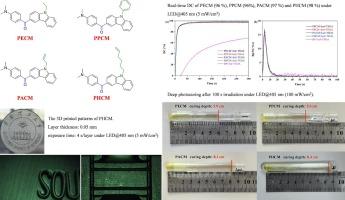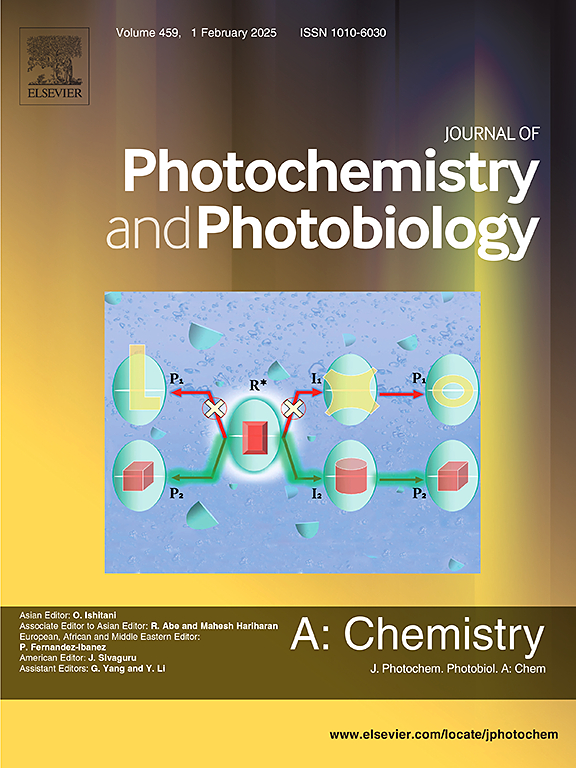Novel benzophenone derivatives photoinitiators based on carbazole group for deep curing and fast 3D printing
IF 4.1
3区 化学
Q2 CHEMISTRY, PHYSICAL
Journal of Photochemistry and Photobiology A-chemistry
Pub Date : 2024-11-10
DOI:10.1016/j.jphotochem.2024.116144
引用次数: 0
Abstract
With the development of photopolymerization in thick film curing, the design and synthesis of effective photoinitiators are becoming increasingly critical. A series of photoinitiators (4-(dimethylamino)phenyl)(9-ethyl-9H-carbazol-3-yl)methanone (PECM), (4-(dimethylamino)phenyl)(9-phenyl-9H-carbazol-3-yl)methanone (PPCM), (9-allyl-9H-carbazol-3-yl)(4-(dimethylamino)phenyl)methanone (PACM), and (4-(dimethylamino)phenyl)(9-(hex-5-en-1-yl)-9H-carbazol-3-yl)methanone (PHCM) based on carbazole group were synthesized for thick film curing. These photoinitiators exhibited the maximum absorption wavelength red-shifted to 353 nm compared to BP and had high molar absorption coefficients (over 27,000 L·mol−1·cm−1). Under the irradiation of LED, the three-component system composed of photoinitiator, diphenyliodonium hexafluorophosphate, and triethanolamine could initiate the rapid photopolymerization of polyethylene glycol diacrylate (PEGDA 400). Under low intensity LED@405 nm (5 mW/cm2) irradiation, PHCM achieved a final double bond conversion (DC) of 98 % within 20 s, significantly higher than BP (65 %). Under the irradiation of LED@365 nm (5 mW/cm2), PHCM reached 99 % DC within 8 s, while BP reached 97 % within 20 s. This performance was attributed to the fact that the molar absorption coefficients of PHCM at 365 nm (30010 L·mol−1·cm−1) and 405 nm (746 L·mol−1·cm−1) were much higher than those of BP (71 L·mol−1·cm−1, 46 L·mol−1·cm−1). Additionally, curing depth of PHCM reached 8.4 cm after 100 s irradiation under LED@405 nm. PHCM also demonstrated excellent cell compatibility and migration ratio as low as 1.8 %, which was 1/5 of that of BP (9.5 %). Furthermore, PHCM was suitable for 3D printers with 4 s/layer. In addition, the initiation mechanism of the photoinitiator was studied by photodegradation and ESR tests.

基于咔唑基团的新型二苯甲酮衍生物光引发剂,用于深度固化和快速 3D 打印
随着光聚合技术在厚膜固化领域的发展,设计和合成有效的光引发剂变得越来越重要。一系列光引发剂(4-(二甲基氨基)苯基)(9-乙基-9H-咔唑-3-基)甲酮(PECM)、(4-(二甲基氨基)苯基)(9-苯基-9H-咔唑-3-基)甲酮(PPCM)、合成了基于咔唑基团的 (9-烯丙基-9H-咔唑-3-基)(4-(二甲基氨基)苯基)甲酮 (PACM) 和 (4-(二甲基氨基)苯基)(9-(己-5-烯-1-基)-9H-咔唑-3-基)甲酮 (PHCM),用于厚膜固化。与 BP 相比,这些光引发剂的最大吸收波长红移至 353 nm,并具有较高的摩尔吸收系数(超过 27,000 L-mol-1-cm-1)。在 LED 的照射下,由光引发剂、二苯碘鎓六氟磷酸盐和三乙醇胺组成的三组分体系可引发聚乙二醇二丙烯酸酯(PEGDA 400)的快速光聚合。在低强度 LED@405 nm(5 mW/cm2)照射下,PHCM 在 20 秒内实现了 98% 的最终双键转化率(DC),显著高于 BP(65%)。在 365 纳米 LED@365 纳米(5 mW/cm2)的照射下,PHCM 在 8 秒内达到了 99% 的双键转化率,而 BP 在 20 秒内达到了 97% 的双键转化率。PHCM 在 365 纳米(30010 L-mol-1-cm-1)和 405 纳米(746 L-mol-1-cm-1)的摩尔吸收系数远高于 BP(71 L-mol-1-cm-1、46 L-mol-1-cm-1)。此外,在 LED@405 纳米波长下照射 100 秒后,PHCM 的固化深度达到 8.4 厘米。PHCM 还表现出优异的细胞相容性,迁移率低至 1.8%,是 BP(9.5%)的 1/5。此外,PHCM 适用于 4 秒/层的 3D 打印机。此外,还通过光降解和 ESR 测试研究了光引发剂的引发机制。
本文章由计算机程序翻译,如有差异,请以英文原文为准。
求助全文
约1分钟内获得全文
求助全文
来源期刊
CiteScore
7.90
自引率
7.00%
发文量
580
审稿时长
48 days
期刊介绍:
JPPA publishes the results of fundamental studies on all aspects of chemical phenomena induced by interactions between light and molecules/matter of all kinds.
All systems capable of being described at the molecular or integrated multimolecular level are appropriate for the journal. This includes all molecular chemical species as well as biomolecular, supramolecular, polymer and other macromolecular systems, as well as solid state photochemistry. In addition, the journal publishes studies of semiconductor and other photoactive organic and inorganic materials, photocatalysis (organic, inorganic, supramolecular and superconductor).
The scope includes condensed and gas phase photochemistry, as well as synchrotron radiation chemistry. A broad range of processes and techniques in photochemistry are covered such as light induced energy, electron and proton transfer; nonlinear photochemical behavior; mechanistic investigation of photochemical reactions and identification of the products of photochemical reactions; quantum yield determinations and measurements of rate constants for primary and secondary photochemical processes; steady-state and time-resolved emission, ultrafast spectroscopic methods, single molecule spectroscopy, time resolved X-ray diffraction, luminescence microscopy, and scattering spectroscopy applied to photochemistry. Papers in emerging and applied areas such as luminescent sensors, electroluminescence, solar energy conversion, atmospheric photochemistry, environmental remediation, and related photocatalytic chemistry are also welcome.

 求助内容:
求助内容: 应助结果提醒方式:
应助结果提醒方式:


